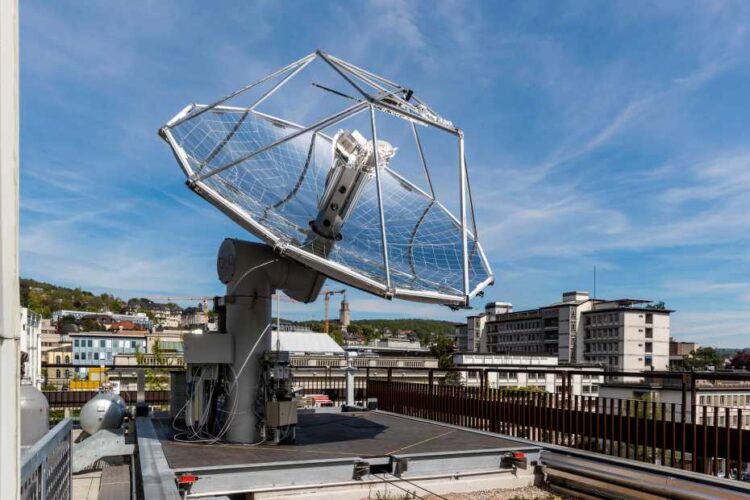Making Aircraft Fuel From Sunlight and Air

The research plant is located on the roof of the ETH building on Sonneggstrasse. © ETH Zurich / Alessandro Della Bella
Scientists at ETH Zurich have built a plant that can produce carbon-neutral liquid fuels from sunlight and air. The next goal will be to take this technology to industrial scale and achieve competitiveness. In a paper published in the scientific journal “Nature”, researchers from Zurich and Potsdam describe how this novel solar reactor functions and outline a policy framework that would provide incentives to expand the production of “solar kerosene”.
Carbon-neutral fuels are crucial for making aviation and maritime transport sustainable. The plant developed in Zurich can be used to produce synthetic liquid fuels that release as much CO2 during their combustion as was previously extracted from the air for their production. CO2 and water are extracted directly from ambient air and split using solar energy. This process yields syngas, a mixture of hydrogen and carbon monoxide, which is then processed into kerosene, methanol, or other hydrocarbons.
A team of researchers led by Aldo Steinfeld, Professor of Renewable Energy Sources at ETH Zurich, have been operating the mini solar refinery on the roof of ETH’s Machine Laboratory building in Zurich over the last two years. “This plant successfully demonstrates the technical feasibility of the entire thermochemical process for converting sunlight and ambient air into drop-in fuels. The system operates stably under real-world solar conditions and provides a unique platform for further research and development,” says Steinfeld. The technology is now sufficiently mature for use in industrial applications.
Desert offers ideal conditions
Analyses of the entire process show that the fuel would cost 1.20 to 2 euros per litre if it were produced on an industrial scale. Desert regions with high solar resources are particularly suitable as production sites. “Unlike with biofuels, whose potential is limited due to the scarcity of agricultural land, this technology enables us to meet global demand for jet fuel by using less than one percent of the world’s arid land and would not compete with the production of food or livestock feed,” explains Johan Lilliestam, a research group leader at the IASS and professor of energy policy at the University of Potsdam. If the materials used to build the production facilities, such as glass and steel, are manufactured using renewable energy and carbon-neutral methods, emissions can be further reduced to close to zero.
Supportive policies needed
However, given the high initial investment costs, solar fuels will need political support to secure their market entry. “The European Union’s existing support instruments – emissions trading and offsetting – are not sufficient to stimulate market demand for solar fuels. In view of this, we propose the adoption of a European technology-specific quota system for aviation fuel. This would require airlines to acquire a specific share of their fuel from solar sources,” explains Lilliestam.
The study’s authors recommend a share of 0.1 percent in the earliest phase of market adoption, when the price of “solar kerosene” will be high and production capacities low. This would have little impact on the cost of flying, but would promote the construction of production facilities and set in motion a learning curve that could lead to technological enhancements and lower prices. The quota could then be gradually increased until solar kerosene achieves a market breakthrough without further support measures.
Wissenschaftliche Ansprechpartner:
Prof. Dr. Johan Lilliestam
johan.lilliestam@iass-potsdam.de
Originalpublikation:
Schäppi R., Rutz D., Dähler F., Muroyama A., Haueter P., Lilliestam J., Patt A., Furler P., Steinfeld A. Drop-in fuels from sunlight and air. Nature, in press 2021, https://www.nature.com/articles/s41586-021-04174-y
Weitere Informationen:
Youtube video on solar kerosene with Johan Lilliestam: https://youtu.be/JQwGrG0fGlY
Photo and video material available via the website of ETH Zurich: https://ethz.ch/en/news-and-events/media-information/background-information/sola…
Media Contact
All latest news from the category: Power and Electrical Engineering
This topic covers issues related to energy generation, conversion, transportation and consumption and how the industry is addressing the challenge of energy efficiency in general.
innovations-report provides in-depth and informative reports and articles on subjects ranging from wind energy, fuel cell technology, solar energy, geothermal energy, petroleum, gas, nuclear engineering, alternative energy and energy efficiency to fusion, hydrogen and superconductor technologies.
Newest articles

Innovative 3D printed scaffolds offer new hope for bone healing
Researchers at the Institute for Bioengineering of Catalonia have developed novel 3D printed PLA-CaP scaffolds that promote blood vessel formation, ensuring better healing and regeneration of bone tissue. Bone is…

The surprising role of gut infection in Alzheimer’s disease
ASU- and Banner Alzheimer’s Institute-led study implicates link between a common virus and the disease, which travels from the gut to the brain and may be a target for antiviral…

Molecular gardening: New enzymes discovered for protein modification pruning
How deubiquitinases USP53 and USP54 cleave long polyubiquitin chains and how the former is linked to liver disease in children. Deubiquitinases (DUBs) are enzymes used by cells to trim protein…



